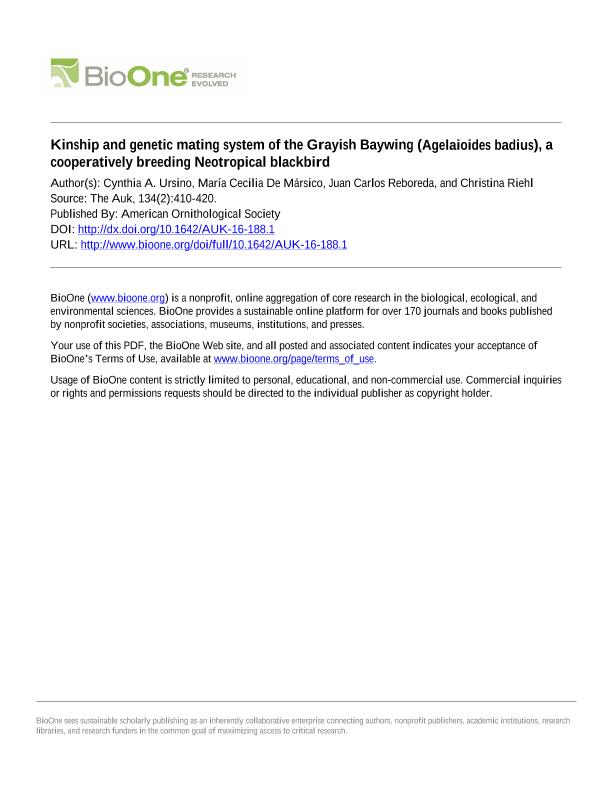Mostrar el registro sencillo del ítem
dc.contributor.author
Ursino, Cynthia Alejandra

dc.contributor.author
de Marsico, Maria Cecilia

dc.contributor.author
Reboreda, Juan Carlos

dc.contributor.author
Riehl, Christina

dc.date.available
2018-11-23T14:56:12Z
dc.date.issued
2017-04
dc.identifier.citation
Ursino, Cynthia Alejandra; de Marsico, Maria Cecilia; Reboreda, Juan Carlos; Riehl, Christina; Kinship and genetic mating system of the Grayish Baywing (Agelaioides badius), a cooperatively breeding Neotropical blackbird; American Ornithologists' Union; Auk; 134; 2; 4-2017; 410-420
dc.identifier.issn
0004-8038
dc.identifier.uri
http://hdl.handle.net/11336/64990
dc.description.abstract
Kin selection theory predicts that extrapair mating should be rare in cooperatively breeding birds. However, most cooperative breeders are not genetically monogamous and the relationship between promiscuity and cooperative breeding remains unclear. This relationship is further complicated by a lack of data. The majority of cooperatively breeding birds live in the tropics, and their genetic mating systems are little known. Here we studied the genetic mating system of the Grayish Baywing (Agelaioides badius), a socially monogamous Neotropical blackbird in which most nesting pairs are assisted by helpers, previously assumed to be offspring of the breeding pair. Grayish Baywings are the primary host of the parasitic Screaming Cowbird (Molothrus rufoaxillaris), and previous studies have found a positive association between brood parasitism and helper recruitment in the last part of the nestling period. We used microsatellite markers to analyze the kinship of 192 individuals in 47 breeding groups, finding that 13% of 153 nestlings (in 38% of 47 nests) resulted from extrapair mating. We also documented 2 instances of conspecific brood parasitism and 1 instance of quasiparasitism (the nestling was sired by the social father, but was unrelated to the social mother). Of 8 helpers that were genotyped, 4 (all males) were offspring of the breeding pair and 4 (2 males, 2 females) were unrelated to both members of the breeding pair. None of the helpers produced offspring within the clutch. These results suggest that, although cooperative breeding is frequent, genetic relatedness between Grayish Baywing helpers and the offspring that they raise is highly variable. Future studies are needed to determine why unrelated helpers assist at Grayish Baywing nests, and to understand the role that brood parasitism may have played in the evolution of cooperative breeding in this species.
dc.format
application/pdf
dc.language.iso
eng
dc.publisher
American Ornithologists' Union

dc.rights
info:eu-repo/semantics/openAccess
dc.rights.uri
https://creativecommons.org/licenses/by-nc-sa/2.5/ar/
dc.subject
Agelaioides Badius
dc.subject
Cooperative Breeding
dc.subject
Extrapair Mating
dc.subject
Mating System
dc.subject
Microsatellite Markers
dc.subject
Parentage Analysis
dc.subject.classification
Otras Ciencias Biológicas

dc.subject.classification
Ciencias Biológicas

dc.subject.classification
CIENCIAS NATURALES Y EXACTAS

dc.title
Kinship and genetic mating system of the Grayish Baywing (Agelaioides badius), a cooperatively breeding Neotropical blackbird
dc.type
info:eu-repo/semantics/article
dc.type
info:ar-repo/semantics/artículo
dc.type
info:eu-repo/semantics/publishedVersion
dc.date.updated
2018-10-23T18:32:31Z
dc.journal.volume
134
dc.journal.number
2
dc.journal.pagination
410-420
dc.journal.pais
Estados Unidos

dc.journal.ciudad
Chicago
dc.description.fil
Fil: Ursino, Cynthia Alejandra. Consejo Nacional de Investigaciones Científicas y Técnicas. Oficina de Coordinación Administrativa Ciudad Universitaria. Instituto de Ecología, Genética y Evolución de Buenos Aires. Universidad de Buenos Aires. Facultad de Ciencias Exactas y Naturales. Instituto de Ecología, Genética y Evolución de Buenos Aires; Argentina. Universidad de Buenos Aires. Facultad de Ciencias Exactas y Naturales. Departamento de Ecología, Genética y Evolución; Argentina
dc.description.fil
Fil: de Marsico, Maria Cecilia. Consejo Nacional de Investigaciones Científicas y Técnicas. Oficina de Coordinación Administrativa Ciudad Universitaria. Instituto de Ecología, Genética y Evolución de Buenos Aires. Universidad de Buenos Aires. Facultad de Ciencias Exactas y Naturales. Instituto de Ecología, Genética y Evolución de Buenos Aires; Argentina. Universidad de Buenos Aires. Facultad de Ciencias Exactas y Naturales. Departamento de Ecología, Genética y Evolución; Argentina
dc.description.fil
Fil: Reboreda, Juan Carlos. Consejo Nacional de Investigaciones Científicas y Técnicas. Oficina de Coordinación Administrativa Ciudad Universitaria. Instituto de Ecología, Genética y Evolución de Buenos Aires. Universidad de Buenos Aires. Facultad de Ciencias Exactas y Naturales. Instituto de Ecología, Genética y Evolución de Buenos Aires; Argentina. Universidad de Buenos Aires. Facultad de Ciencias Exactas y Naturales. Departamento de Ecología, Genética y Evolución; Argentina
dc.description.fil
Fil: Riehl, Christina. University of Princeton; Estados Unidos
dc.journal.title
Auk

dc.relation.alternativeid
info:eu-repo/semantics/altIdentifier/url/http://www.bioone.org/doi/10.1642/AUK-16-188.1
dc.relation.alternativeid
info:eu-repo/semantics/altIdentifier/doi/https://dx.doi.org/10.1642/AUK-16-188.1
Archivos asociados
